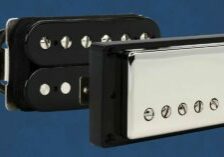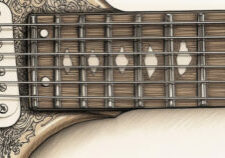Have you ever struggled to achieve good sustain while playing the guitar? No problem. Let’s dive into the ways to maximize sustain on your guitar!
Sustain is a crucial component of creating a powerful sound, but it can be challenging to achieve, especially for beginners. Fortunately, there are both short and long-term fixes that can help maximize guitar sustain, whether you’re a seasoned guitarist or just starting.
Let’s explore the techniques and strategies that can help improve guitar sustain. We will begin by discussing short-term fixes that can be implemented relatively quickly without the need for new equipment or gear. From there, we will move on to long-term solutions that may require a bit more investment but can yield significant improvements in sustain.
Improving Sustain: Key Points
- Gain settings have the biggest impact on sustain. It can come from various sources such as distortion pedals, amplifiers, or rack-mounted effects.
- Investing in quality gear, such as a tube amplifier or quality pickup brands like EMG, Dimarzio, and Seymour Duncan, can provide long-term solutions for improving sustain.
- Sustain can fluctuate even with excellent gear, but good sustain can provide at least seven or eight seconds of attack.
Short-Term Fixes to Improve Sustain
Adjusting your guitar, pedal and amp settings is the fastest way to increase guitar sustain. Here are a few tips to help
Work on Your Amp and Gain Control
Start with your amp. Put all the tone controls at or near half way. If you know your amp well enough, you might already have the tone controls dialed in. For example, I play my main tube amps with a little lower lows and higher treble. It won’t make a big difference if I’m at 6 or 7 on treble. But if you start adjusting for sustain and you have your tone controls too low, you won’t have any success fixing sustain. Turn up the gain and volume knobs until you have the right balance. On some amps, you can turn the gain up but keep the master volume lower and still get good sustain at low volumes.
Adjusting the guitar’s action
Lowering the action, which refers to the strings’ height from the fretboard, can allow for easier string vibration and improve sustain.
Checking and replacing worn-out strings
Over time, guitar strings can lose their elasticity and sustain. Replacing old strings with new ones can provide a quick boost in sustain, as fresh strings tend to resonate more effectively.
Utilizing a heavier guitar pick
Experimenting with different picks, particularly ones with thicker gauges, can help generate more energy when striking the strings. This extra force can lead to increased sustain.
Applying lighter touch and reducing excessive muting
Sometimes, excessive pressure or muting techniques can inhibit string vibration and reduce sustain. By applying a lighter touch and minimizing unintentional muting, sustain can be improved.
Adjusting pickup height
If the guitar is equipped with magnetic pickups, adjusting their height can affect sustain. Raising the pickups closer to the strings can increase the pickup’s sensitivity and sustain, while lowering them can provide a different tonal balance.
Experimenting with different playing techniques
Certain playing techniques, such as palm muting or using legato techniques like hammer-ons and pull-offs, can influence sustain. Exploring and implementing different techniques can help find the ones that maximize sustain for a particular guitar.
Adjusting the guitar’s intonation
Ensuring that the guitar is properly intonated can improve sustain. When a guitar is properly intonated, the notes played at different positions on the fretboard will be more accurately in tune, promoting better sustain and resonance.
Long-Term Solutions for Better Sustain
Investing in high-quality gear is crucial for achieving optimal sustain and tone on the guitar, according to industry experts. If you have a cheap guitar thats poorly constructed and a small inexpensive amp, then there will be a limit to how much you can improve sustain.
Long term solutions for improving guitar sustain through better gear
Long-term solutions for improving guitar sustain through better gear involve a combination of careful selection and proper maintenance of equipment, as well as exploring innovative technologies and techniques. Here are some key areas to focus on:
Quality Instruments
Investing in a well-made guitar with good sustain characteristics can significantly enhance your playing experience. Look for guitars made from high-quality tonewoods, such as mahogany or maple, which can enhance sustain.
Upgraded Pickups
Upgrading your guitar’s pickups can have a dramatic impact on sustain. Consider installing high-output humbuckers or single-coil pickups specifically designed to increase sustain. Active pickups, like those found in some metal-oriented guitars, can also provide extended sustain capabilities. Installing new pickups from brands like EMG, Dimarzio, and Seymour Duncan can make a big difference.
Bridge and Tailpiece Upgrades
The bridge and tailpiece play a crucial role in transferring vibrations from the strings to the body of the guitar. Consider upgrading to a higher-quality bridge and tailpiece, such as those made of solid metal, to optimize sustain. On a Fender Stratocaster, there is a block that connects to the tremolo. It is fairly common for strat players to upgrade to larger, heavier blocks that improve sustain.
Effects Pedals and Processors
Utilizing sustain-enhancing effects pedals or processors can give you more control over your sustain levels. Compressors, sustain pedals, or even rack-mounted processors can help sustain notes for longer durations, giving you more sustain during leads or solos.
Frequently Asked Questions
What are some common mistakes people make when trying to increase guitar sustain?
Common mistakes people make when trying to increase guitar sustain include relying solely on gear without adjusting settings, not considering the impact of amp settings on sustain, and investing in low-quality gear. It’s important to balance gear and settings for optimal sustain.
Can sustain be improved on acoustic guitars as well as electric guitars?
Sustain on acoustic guitars can be improved by using heavier gauge strings, choosing a guitar with a solid top, and adjusting the bridge and nut height. However, electric guitars have more options for increasing sustain through gear adjustments and upgrades.
Is it better to invest in a new guitar or amplifier for sustain improvement?
A new improved guitar will help, but often times installing new pickups in an existing guitar can work wonders. It really depends on whether you like your current guitar and if you have the budget.
How do different types of strings impact guitar sustain?
The sustain of a guitar can be impacted by the type of strings used. Thicker gauge strings can provide more sustain due to their higher tension, while lighter gauge strings may have less sustain but provide better playability.
Can sustain be affected by the player’s technique or playing style?
Sustain can be affected by the player’s technique or playing style. Proper fretting, picking, and vibrato techniques can improve sustain.
Sustain on a Guitar
Thats everything I can think of. There may be some obscure products that can help, but these techniques and gear upgrades will make the biggest difference. Also, it can help if your amps go to 11.





